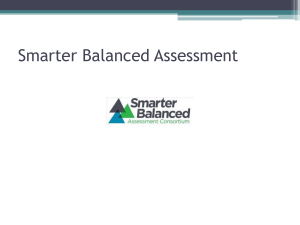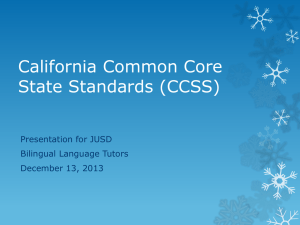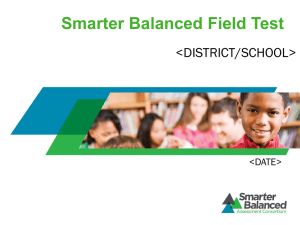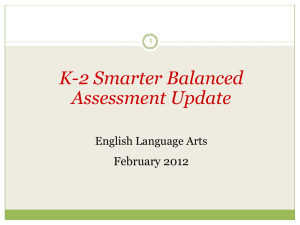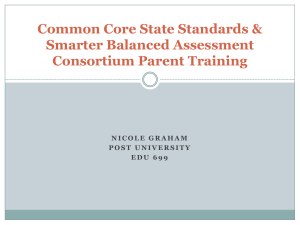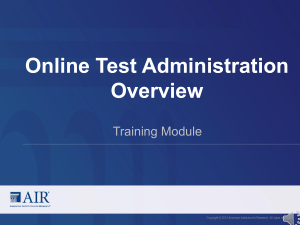Unit 2 - Twin Rivers Unified School District
advertisement
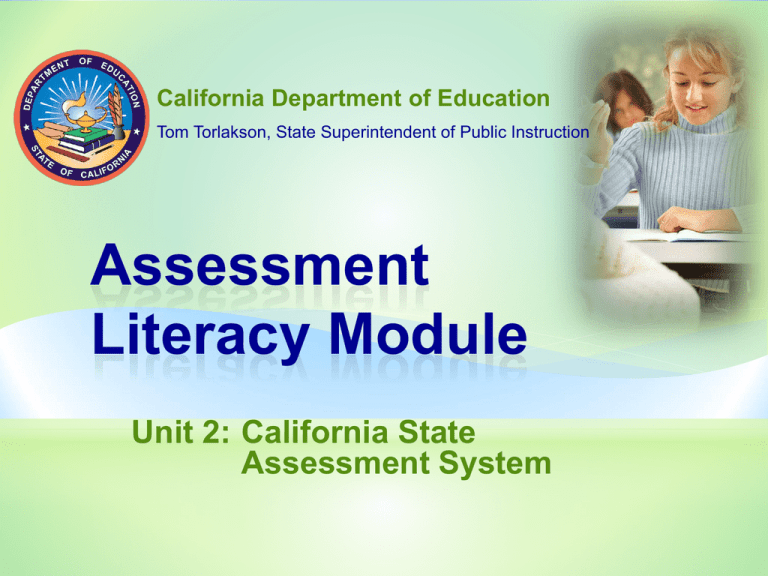
California Department of Education Tom Torlakson, State Superintendent of Public Instruction Assessment Literacy Module Unit 2: California State Assessment System Welcome to Unit 2 The purpose of this unit is to increase your knowledge of the components of California’s new state assessment system. 2 Learning Objectives for Unit 2 By the end of this unit, participants will be able to: Explain the purpose and characteristics of the new assessment system for California, the Measurement of Academic Performance and Progress (MAPP) Describe plans for aligning components of the CA CCSS and new assessment system that are unique to English learners and students with disabilities 3 A Balanced Assessment System This graphic illustrates the components of the Smarter Balanced assessment system. Notice the multiple assessment points included. 4 Coherent System Components This table provides additional detail on each of the Smarter Balanced assessment system components. How does this system differ from the STAR Program? Components of the Smarter Balanced Assessment System Type of Assessment When Administered Format/Structure Assessment Methods Purpose/Use Summative Last 12 weeks of school year Two parts: Computer Adaptive and Performance Assessment Selected Response; Constructed Response; Performance Tasks; Technology- Enhanced Assess student achievement growth as part of program evaluation and school, district, and state accountability Interim Locally determined intervals Two parts: Computer Adaptive and Performance Assessment Selected Response; Constructed Response; Performance Tasks; Technology- Enhanced Progress monitoring; identifying strengths and needs in relation to the CA CCSS Formative Tools and Practices Daily classroom use Digital, on-demand library of practices, tools, and resources Not Applicable Progress monitoring; identifying individual student and student group strengths and needs in relation to the CA CCSS; Professional learning for teachers 5 Assessment Methods and Item Types Technology-Enhanced Items Example TE items are available on the Smarter Balanced Web site: Grades 3–5 ELA: Grandma Ruth 2 http://sampleitems.smarterbalanced.org/itempreview/sbac/ ELA.htm High School Math: Water Tank http://sampleitems.smarterbalanced.org/itempreview/ ModernShell.aspx?config=SBAC\Content\WaterTank.json 6 Assessment Methods and Item Types Performance Tasks Grades 3–5 ELA: Animal Defenses http://www.smarterbalanced.org/wordpress/wp-content/uploads/ 2012/09/performance-tasks/animal-performance.pdf Grades 3–5 Math: Planting Tulips http://www.smarterbalanced.org/wordpress/wp-content/uploads/ 2012/09/performance-tasks/tulips.pdf Grades 6–8 ELA: Garden of Learning http://www.smarterbalanced.org/wordpress/wp-content/uploads/ 2012/09/performance-tasks/garden.pdf 7 Assessment Methods and Item Types Additional sample items available on the Smarter Balanced Sample Items and Performance Tasks Web page at http://www.smarterbalanced.org/sample-items-and-performancetasks/. Learn more about California’s role in the development of the Smarter Balanced Digital Library of formative assessment practices and tools: http://www.cde.ca.gov/ta/tg/sa/diglib.asp 8 Smarter Balanced Preliminary Blueprints Depth of Knowledge Level 1: Recall and Reproduction Requires eliciting information such as a fact, definition, term, or a simple procedure, as well as performing a simple algorithm or applying a formula. Level 2: Basic Skills and Concepts Requires the engagement of some mental processing beyond a recall of information. Level 3: Strategic Thinking and Reasoning Requires reasoning, planning, using evidence, and explanations of thinking. Level 4: Extended Thinking Requires complex reasoning, planning, developing, and thinking most likely over an extended period of time. 9 English Language Assessment Students in kindergarten through grade twelve whose home language is not English are required to take an annual English language proficiency assessment based on English Language Development (ELD) standards. California’s current assessment is the California English Language Development Test (CELDT) and is based on the 1999 ELD standards. The English Learner Proficiency Assessment for California (ELPAC) will be first administered in 2015–16 and will be aligned to the 2012 ELD Standards for California Public Schools and the CA CCSS. The system’s goal is to maximize assessment information on language development to support English learners’ attainment of the CA CCSS. The 2012 ELD Standards for California Public Schools are available on the CDE English Language Development Standards Web page at http://www.cde.ca.gov/sp/el/er/eldstandards.asp. 10 Implementation Timeline A tentative development process and timeline have been established for the ELPAC, culminating in the implementation of a new system in 2015–16. Steps in the process are expected to include: The California English Language Development Standards Implementation Plan is available on the CDE English Language Development Standards Web page at http://www.cde.ca.gov/sp/el/er/eldstandards.asp. 11 Assessment Accessibility Access by Design Smarter Balanced assessment items are designed to be accessible to a broad spectrum of students, including English learners, students with learning disabilities, students with vision needs who require braille and/or tactile supports, students who require audio representation, and students who communicate in American Sign Language. 12 Assessment Accessibility Access by Design Under STAR Program testing, test variations, accommodations, and modifications available to students are specified on the Testing Variations, Accommodations and Modifications Matrix (http://www.cde.ca.gov/ta/tg/sr/). Developers of the new assessments are using Smarter Balanced General Accessibility Guidelines to support implementation of assessment inclusion strategies from an innovative approach called Access by Design: http://www.smarterbalanced.org/wordpress/wpcontent/uploads/2012/05/TaskItemSpecifications/Guidelines/Accessi bilityandAccommodations/GeneralAccessibilityGuidelines.pdf 13 Students with Significant Cognitive Disabilities The NCSC alternate assessments are designed to reach a wide range of students with significant cognitive disabilities and will assess knowledge in grades 3–8 and once in high school. These alternate assessments will align with the assessment systems being developed by Smarter Balanced and will be ready for use by the 2014–15 school year. For more information on alternate assessments, visit the NCSC Web site at http://www.ncscpartners.org/. 14 Summary of Unit 2 English learners and students with disabilities will have access to Smarter Balanced assessments through a variety of universal-design principles integrated into the system. English learners’ access to the CA CCSS will be maximized through alignment of the new ELPAC to the new California ELD standards. Students with significant cognitive disabilities will participate in a CA CCSS-aligned assessment system. 15

